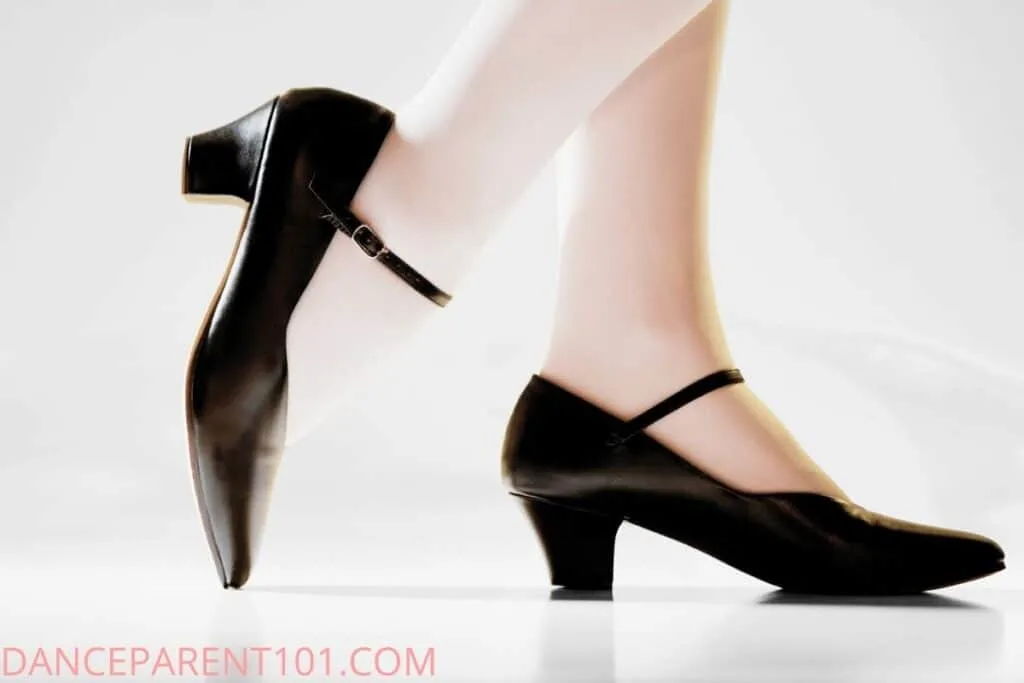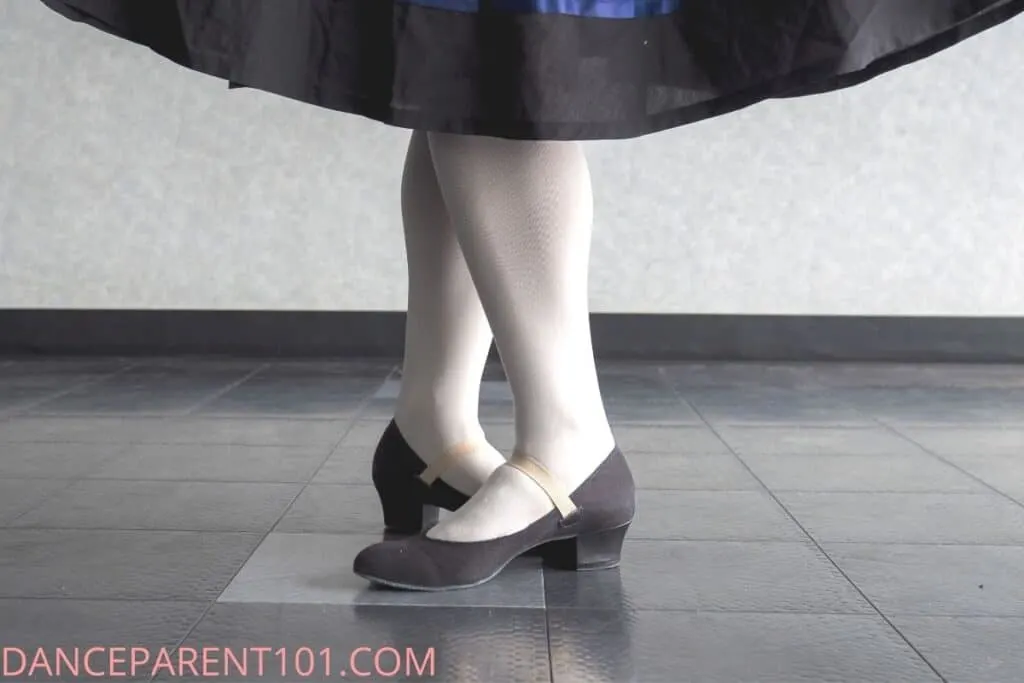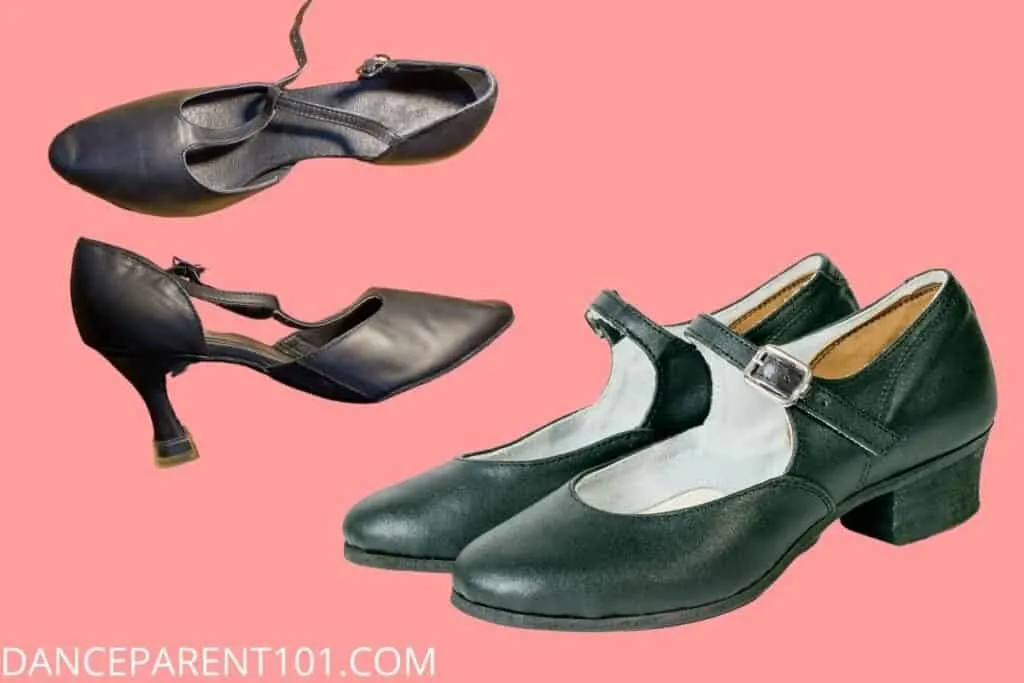By Lesley Mealor / Edited by Samantha Bellerose, B.Ed, Dip.Dance(Performing Arts)
Character shoes are used in ballet, theatre dance, and jazz dance. Adding a more mature and stylized look to a costume, character shoes are often reserved for more advanced dancers as they are more difficult to dance in due to the added height of the heel, which affects balance and center of gravity.
In order to choose the best character shoes, you must first know what style of dance they will be used for. Once you know the genre of dance, you can then choose from the variety of styles, colors, materials, and heel heights that character shoes come in.

Character shoes come in black and beige, and range in price from $25 USD for basic shoes to $400 USD for professional-level shoes. Always consult your studio’s dress code for their specific requirements. Read on for a complete breakdown of the types of character shoes on the market and how to choose the right ones for your dancer.
What Kind of Character Shoes Are There?
| Type of Character Shoe | Style of Dance |
|---|---|
| Soft character shoes with a small heel | Ballet |
| Hard character shoes with a 1.5”-3” heel | Ballet, theatre dance |
| Split-sole character shoes with a 1.5”-3” heel | Theatre dance, jazz |
What Are the Best Soft Character Shoes For Ballet Class?

The best character shoes for ballet class are soft character shoes made of canvas material with a suede sole, along with a small heel. They have an elastic strap similar to ballet shoes, and come in black. Soft character shoes are used in character ballet, which is a style that is adjacent to classical ballet. Many dance studios offer character class in tandem with classical ballet, or simply use character shoes as part of a costume for certain performances.
Soft character shoes have the benefit of feeling like regular ballet shoes, only with the addition of the heel for some visual flair and style. Occasionally, the heel is used in some steps and choreography to make a sound. Most often, you will see black character shoes in ballet.
How Should Soft Character Shoes Fit?
Soft character shoes should fit just like soft ballet shoes, snug like a sock with little to no room to grow. There is sometimes a drawstring to tighten the shoes, and if there is not already an elastic strap sewn across the shoe, that can be added if you feel you need additional support.
What are the Best Hard Soled Character Shoes for Ballet, Jazz and Theatre Dance?

Hard soled character shoes are generally used for jazz and theatre dance by students and dance studios. They come in a few different styles and materials, as well as different heel heights. Options you can choose from include:
- Single strap or T-strap
- Leather or synthetic leather
- 1.5”, 2”, 2.5″ and 3″ heel
In order to choose the best hard-soled character shoes for your dancer, consider their age and level. Younger dancers will benefit from a shorter heel, and with growing feet, it may make more sense to purchase a synthetic leather shoe the Capezio light foot with a 1.5” heel.
The choice between T-strap and single strap is one of preference, although most shorter heels only come in the single strap option. A T-strap shoe has the added benefit of being a little more supportive. Your studio or dance school may have a preference as well so make sure you check with them first before buying a pair!
An older, more advanced dancer needing hard character shoes for ballet, jazz or theatre classes may enjoy a higher heel, like the 2” Chord t-bar design offered by Bloch. While character shoes come in black and tan, you will see mostly black character shoes for ballet.
How Should Hard Soled Character Shoes Fit?
Hard soled character shoes should fit like a dress shoe, with all ten toes able to lie comfortably flat without crunching or overlapping. Hard soled shoes are difficult to break in, especially if they are made of a synthetic material, so take care to have your dancer wear them around the house (not outside!) to get used to how they feel. Over time, they will become more flexible and easier to dance in.
What Kind of Character Shoes Are Best For Jazz and Theatre Dance?
The best kind of character shoe for jazz and theatre dance are split-sole, leather character shoes with a 1.5”-3” heel, in either tan or black. Split-sole character shoes have a suede sole and arch, to allow for flexibility and easy turns. Once a dancer is more advanced, it may be required to have a pair of character shoes for more stylized routines.
Split-sole character shoes have the benefit of being incredibly flexible, but are also less stable than a full-sole, hard character shoe, which is why dancers are usually older and more advanced before they’re asked to dance in character shoes.
A character shoe adds style, height, and a certain maturity to the look of a dancer’s line, which is why you often see professional dancers like the Rockettes and dancers in musicals in character heels.
If you are looking for the most professional option, La Duca is the brand of split-sole character shoes to invest in. Priced between $225 USD and $385 USD, La Ducas are a status symbol of dancers around the world and come in multiple styles, colors, and heel heights. For a less expensive but still durable and professional option, Bloch’s Split Flex Character Shoe comes in black and tan, in a 2.5” heel and is priced at $98 USD.
How Should Split-Sole Character Shoes Fit?
Spit-sole character shoes should fit like a glove, if not a little tighter. The reason for this extra-tight fit is that since split-sole character shoes are made of leather and suede, they will stretch easily as they are worn and broken in. When the foot is pointed in a split-sole heeled shoe, the front of the shoe moves slightly forward. Most split-sole character shoes come with a T-strap for support.
If the shoe is at all too big or has stretched out, there is a risk of the front of the foot slipping out of the shoe. The tight fit actually becomes a way to keep the dancer safe while dancing. A loose character shoe runs the risk of shifting on the foot, possibly creating instability for the dancer.
When making an investment as expensive as some of the character shoes on the market, it is best to try on the shoes at a store if possible. If not, consult the store directly to ensure you are purchasing the correct size for your dancer.
Character shoes are a fun, special addition to a dancer’s footwear collection. With this helpful information, you are sure to be able to choose the correct character shoes for your dancer!
